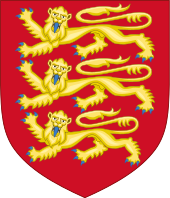Abbot of Peterborough
A list of the abbots of the abbey of Peterborough, known until the late 10th century as "Medeshamstede".
Abbots
| Name | Dates | Works | Notes |
|---|---|---|---|
| Sexwulf | c. 654– c. 676 |
Founder. Bishop of Mercia c. 676–?x692. | |
| Cuthbald | c. 676 | ||
| Egbald | before 716 | ||
| Pusa | |||
| Botwine | ?x765– 779x? |
||
| Beonna | ?x789– 805x? |
||
| Ceolred | |||
| Hedda | 870 | ||
| Ealdwulf | 972-992 | Archbishop of York, 995-1002. | |
| Cenwulf | 992-1006 | Built wall around the abbey. | Bishop of Winchester, 1006. |
| Ælfsige | 1006–1042 | Accompanied Æthelred the Unready and Emma to Normandy in 1013. | |
| Earnwig | 1042–1052 | A "very good man and very sincere", he "resigned although still in good health". | |
| Leofric | 1057–1066 | Endowed the monastery "so that it became known as 'Golden Borough'". | |
| Brand | 1066–1069 | ||
| Thorold/Torold de Fécamp | 1069–1098 | Viewed the abbey as a source of personal wealth for himself and his associates with his enfeoffments accounting for 46% of the abbey's property. | |
| Godric | 4 days in 1099 | ||
| Matthias | 1103–1104 | ||
| Ernulf | 1107–1114 | Began a building campaign. | Bishop of Rochester, 1115. He was influential in restoring the abbey's finances. |
| John de Séez | 1114–1125 | Continued the building work and, though in 1116 a great fire caused considerable damage, rebuilding began in 1117. | |
| Abbey held by King Henry I | 1125–1127 | ||
| Henry de Angeli | 1128–1133 | Did nothing towards the rebuilding. | He wasted the goods of the abbey and was banished. |
| Martin de Bec | 1133–1155 | Continued construction works. | Formerly a monk of Bec and prior of St Neots. |
| William of Waterville | 1155–1175 | Deposed | |
| Benedict | 1177–1194 | Chronicler. | |
| Andrew | 1194–1199 | West front. | |
| Acharius | 1200–1210 | West front. | |
| Robert of Lindsey | 1214–1222 | ||
| Alexander of Holderness | 1222–1226 | ||
| Martin of Ramsey | 1226–1233 | ||
| Walter of Bury St. Edmunds | 1233–1245 | Abbot at the time of the building's final completion through the solemn dedication of the church on 6, October 1238. | |
| William of Hotoft | 1246–1249 | ||
| John de Caux | 1250–1262 | ||
| Robert of Sutton | 1262–1273 | ||
| Richard of London | 1274–1295 | ||
| William of Woodford | 1295–1299 | ||
| Godfrey of Crowland | 1299–1321 | A chapel of St Thomas of Canterbury was built between the church and the Lady Chapel. | |
| Adam of Boothby | 1321–1338 | ||
| Henry of Morcott | 1338–1353 | ||
| Robert of Ramsey | 1353–1361 | ||
| Henry of Overton | 1361–1391 | ||
| Nicholas of Elmstow | 1391–1396 | ||
| William Genge | 1397–1408 | ||
| John Deeping | 1409–1439 | ||
| Richard Ashton | 1439–1471 | ||
| William Ramsey | 1471–1496 | ||
| Robert Kirton | 1496–1528 | The latest part of the church, and the only ever enlargement of the eastern arm, the square ended building at the east known as "the new building". | |
| John Chambers | 1528–1539 | Rewarded for complicity during the Dissolution with being made first bishop of Peterborough - care for the former abbey church, which became the bishop's cathedral, passed to the dean of Peterborough. |
Sources
- 'Houses of Benedictine monks: The abbey of Peterborough', A History of the County of Northampton: Volume 2 (1906), pp. 83–95. http://www.british-history.ac.uk/report.asp?compid=40221. Date accessed: 29 May 2007.
- Peterborough Chronicle.
- Stenton, F.M., "Medeshamstede and its Colonies", in Stenton, D.M. (ed.), Preparatory to 'Anglo-Saxon England'being the collected Papers of Frank Merry Stenton, OUP, 1970.
gollark: Yes, but that would be very obvious.
gollark: Hmm, yes, but he has less accountability this way.
gollark: I don't necessarily trust him.
gollark: > maybe, but it was spun off from your previous strategic voting group to remove me and you considered delaying it when you considered not voting until I'd been a badminWhat if I told you that XENON CIRCUMVENTION was just made up so we could seem like we had an actual long-term plan?
gollark: Solution: cryptography and also non-anonymized voting.
This article is issued from Wikipedia. The text is licensed under Creative Commons - Attribution - Sharealike. Additional terms may apply for the media files.
